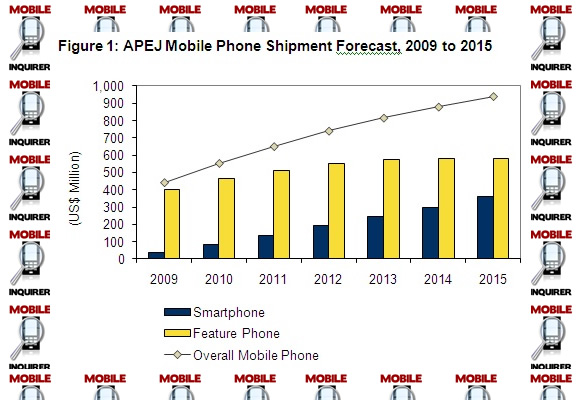Penetration of smartphones and tablets to equal Western Europe and the US for Asian countries:
With the current penetration of smartphones set at the 40% mark for the US and Western Europe, only a mere 20% of Asia Pacific consumers currently own and use smartphone devices, though interest in buying a smartphone is set at around 50% according to research by the Nielsen group, meaning that the Asia Pacific market looks set to boom in the coming 12 months.

iPhone most desirable item:
The Apple marketing machine appears to have done a grand job over in the Asia Pacific region as the research found by Nielsen shows that even when people currently do not own Apple products 17% of Malaysians are seeking to own an iPhone as first choice for their next mobile device and 11% seek a Blackberry, proving that Apple and RIM’s Blackberry have a high “mind share” relative to their current market positions. Apple and Blackberry currently only command a 1% and 3% share respectively of the market in Malaysia so you can see that desire is high for these new type of devices.
Data use to alter dramatically in the Asia pacific region:
With smartphones designed from the ground up to be more “connected” in relation to the internet, statistics show in the US that smartphones users are 3 times more likely to access the internet than their less enabled cousins (86% v’s 30%). They are also 4 x more likely to access their emails while on the go (80% v’s 20%) all actions that seriously eat up data, this is not even taking into account social media use, watching online video and online game participation.
Many smartphone users already spend over 25% of their time on the social network Facebook.
Tablet sales will only stand to compound the data issue further:
With people in the US and Europe buying more tablet PC’s than expected at the expense of the laptop and desktop. Data packages are now being offered with your tablet purchase to ensure you enjoy a more connected experience when on the go. Whether you opt for a 3G connection to go with your new tablet, or simply stick to a WiFi connection when available, the fact is more and more people are demanding some form of data connection where they perhaps would not have expected it as a result of the growth of tablet PC’s and the ease in which you can use them while on the move.
Multimedia phones masquerade as smartphones in India:
Companies such as Spice and Micromax in India are currently filling a gap created by the desire for a smartphone by offering devices that appear to be smartphones but lack the sophistication offered by Apple or Android, they are churning out what we would term Multimedia phones, yes they have touch screens and yes they can play audio etc and look quite cool, but they are a fraction of the cost and not quite as all singing as their more developed smartphone cousins.
Increased data use creates problems as well as opportunities:
Fast speeds and great connectivity will be key to ensuring that data providers stay ahead of the curve and are not drowned by their competitors in the age of permanently connected devices.
Not being able to monetize the data that is used by consumers presents only one solution for the providers and that is to make sure that they are competitively priced in terms of data packages available and also have excellent service levels to boot.
Smartphones will become very personalised through the operating system and applications that engage with the user:
The level of engagement that the user will expect and desire will become key factors in people staying with an existing operating system or deciding to try a new one. Advertisers will be presented with a brand new market in the Asia Pacific region to tap into with creative use of mobile advertising that will add value to brands and encourage user engagement.
Structure of data plans need to be decided upon:
One thing stopping the growth of smartphones is the availability of data services that people can afford, the Asia Pacific area sees users sceptical whether their mobile package includes enough data allowance to ensure they do not receive hefty bills at the end of the month for going over their current allowance. This mistrust permeates many users in the Asia Pacific area and needs to be addressed to encourage users to be more worry free with their mobile phone use where data is concerned.
Anthony Munns